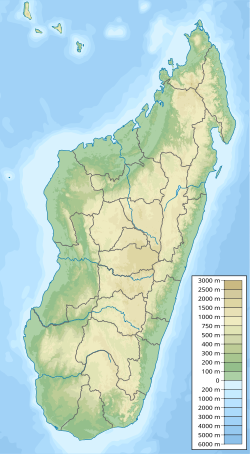| Isalo III Formation | |
|---|---|
| Stratigraphic range: Bajocian-Bathonian ~ | |
| Type | Geological formation |
| Sub-units | Isalo IIIa or Beronono Formation Isalo IIIb or Sakaraha Formation |
| Overlies | Isalo II Formation (unconformity) |
| Lithology | |
| Primary | Sandstone |
| Other | Claystone, marl |
| Location | |
| Coordinates | 16°36′S 47°00′E / 16.6°S 47.0°E |
| Approximate paleocoordinates | 23°54′S 25°06′E / 23.9°S 25.1°E |
| Region | Mahajanga & Fianarantsoa Provinces |
| Country | |
| Extent | Mahajanga Basin |
The Isalo III Formation is a geological formation in Madagascar, off the eastern coast of Africa. It dates back to the Middle Jurassic.[1] The use of the term "Isalo III" is somewhat controversial as the two prior units Isalo I and II are Triassic cross-bedded sandstone units that form a continuous depositional sequence, while the "Isalo III" sandstones are not part of the same depositional sequence, and were deposited considerably later. and are perhaps better treated as part of several separate formations.[2] It is traditionally divided into two subunits the lower, Bajocian aged Isalo IIIa unit also known as the Beronono Formation and the upper, Bathonian aged Isalo IIIb unit also known as the Sakaraha Formation or Sakahara Formation.[3] The Sakaraha Formation consists of sandstones, marls and carbonates and represents a coastal plain environment, and is laterally equivalent to the predominantly carbonate Bemaraha Formation, which represents a coastal barrier lagoon complex.[2] The formation is found in the northwest and in the southeast of the country and has provided a variety of fossils.
